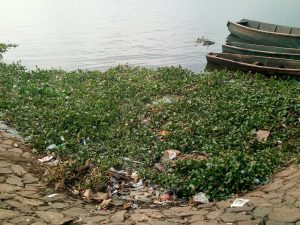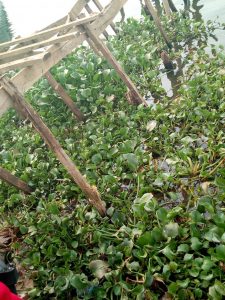
Uganda lake victoria fishery fishermen fishing boat water hyacinth flora aquatic plants floating invasive species environment.
Visiting Lake Victoria, one of the visible features at first sight is the green water hyacinth as some of it forms shapes that can be viewed from a distance stretching towards the islands on the waters.
Water-hyacinth is a floating plant that has clusters of leaves with spongy stalks arising from a base of dark purple feathery roots. The leaf clusters are often linked by smooth horizontal stems- stolon.
Talking to Simon Magezi, one of the elders at Gabba lading site, it is not clear where and when the feature existed on Lake Victoria(Nalubaale).
It is only speculated that the plant is native to South America so it appears to have reached Lake Victoria due to human activity.
“I have lived at this landing site since 194 and this water hyacinth ‘Ekyiddo’ is not something found while growing up. It only came into existence around the time Museveni’s regime came to power and no one should deceive you that he or she knows how it came here but we believe that it must be as a result of nature,” say Magezi.
However, some researchers have it that with its beauty, it might have been brought over as an ornamental for garden ponds. The consensus is that water hyacinth entered Lake Victoria from Rwanda via the river Kagera, probably in the 1980s. The hyacinth has since spread prolifically, as a result of lack of natural predators, an abundance of space, agreeable temperature conditions, and abundant nutrients, including increasing heavy metal pollution in the lake.
According to Ibrahim Kizito, one of the members of the fishing committee at the site, the beautiful species move all over the lake in favor of the wind movements.
“When the wind blows this side, then the water hyacinth moves and just settles in the end sides of the lake for at least weeks or months until the wind changes direction,” submitted Kizito.
However, he added that in most of the times when it fails to move then the locals together with Kampala Capital City Authority (KCCA) take up the initiative to remove it and lean the waters.
There are indications that water hyacinths can provide benefits to the Lake Victoria Region in a way that it attempts to purify eutrophicated water. Once established, the plants can also be harvested and used for biogas production, fertilizer, crafts among other things.
However, it affects the Lake Victorian population in many negative ways that among others are;
Sometimes there are economic impacts when the weed blocks boat movements and access. The effects on transportation and fishing are immediately felt. Where the weed is prolific, there is a general increase in several diseases, as the weed creates excellent breeding areas for mosquitoes and other insects.
It can smother aquatic life by de-oxygenating the water, and it reduces nutrients for young fish in sheltered bays. It has blocked supply intakes for the hydroelectric plant, interrupting electrical power for entire cities. The weed also interrupts local subsistence fishing, blocking access to the beaches.
Water hyacinths increased rapidly between 1992–1998, were greatly reduced by 2001, and have since resurged to a lesser degree. Management techniques include (hyacinth-eating) insect controls and manual beach cleanup efforts. A water hyacinth infestation is seldom totally eradicated. Instead, it is a situation that must be continually managed.


